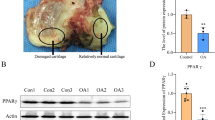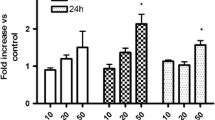Abstract
Pro-inflammatory cytokine-induced chondrocyte apoptosis is a primary cause of cartilage destruction in the progression of rheumatoid arthritis (RA). Advanced oxidation protein products (AOPPs), a novel pro-inflammatory mediator, have been confirmed to accumulate in patients with RA. However, the effect of AOPPs accumulation on chondrocyte apoptosis and the associated cellular mechanisms remains unclear. The present study demonstrated that the plasma formation of AOPPs was enhanced in RA rats compared with normal. Then, chondrocyte were treated with AOPPs-modified rat serum albumin (AOPPs-RSA) in vitro. Exposure of chondrocyte to AOPPs activated nicotinamide adenine dinucleotide phosphate (NADPH) oxidase and increased expression of NADPH oxidase subunits, which was mediated by receptor for advanced glycation end products (RAGE), but not scavenger receptor CD36. Moreover, AOPPs challenge triggered NADPH oxidase-dependent ROS generation which induced mitochondrial dysfunction and endoplasmic reticulum stress resulted in activation of caspase family that eventually lead to apoptosis. Lastly, blockade of RAGE, instead of CD36, largely attenuated these signals. Our study demonstrated first time that AOPPs induce chondrocyte apoptosis via RAGE-mediated and redox-dependent intrinsic apoptosis pathway in vitro. These data implicates that AOPPs may represent a novel pathogenic factor that contributes to RA progression. Targeting AOPPs-triggered cellular mechanisms might emerge as a promising therapeutic option for patients with RA.












Similar content being viewed by others
Abbreviations
- RA:
-
Rheumatoid arthritis
- ROS:
-
Reactive oxygen species
- AOPPs:
-
Advanced oxidation protein products
- MPO:
-
Myeloperoxidase
- NADPH:
-
Nicotinamide adenine dinucleotide phosphate
- RAGE:
-
Receptor for advanced glycation end products
- ER:
-
Endoplasmic reticulum
- chop:
-
C/EBP homologous protein
- PARP:
-
Poly ADP-ribose polymerase
- Δψm:
-
Mitochondrial membrane potential
- RSA:
-
Rat serum albumin
References
McInnes IB, Schett G (2007) Cytokines in the pathogenesis of rheumatoid arthritis. Nat Rev Immunol 7:429–442
Schuerwegh AJ, Dombrecht EJ, Stevens WJ, Van Offel JF, Bridts CH, De Clerck LS (2003) Influence of pro-inflammatory (IL-1 alpha, IL-6, TNF-alpha, IFN-gamma) and anti-inflammatory (IL-4) cytokines on chondrocyte function. Osteoarthritis Cartilage 11:681–687
Polzer K, Schett G, Zwerina J (2007) The lonely death: chondrocyte apoptosis in TNF-induced arthritis. Autoimmunity 40:333–336
Lotz M (2001) Cytokines in cartilage injury and repair. Clin Orthop Relat Res 391:S108–S115
Wruck CJ, Fragoulis A, Gurzynski A, Brandenburg LO, Kan YW, Chan K, Hassenpflug J, Freitag-Wolf S, Varoga D, Lippross S, Pufe T (2011) Role of oxidative stress in rheumatoid arthritis: insights from the Nrf2-knockout mice. Ann Rheum Dis 70:844–850
Fay J, Varoga D, Wruck CJ, Kurz B, Goldring MB, Pufe T (2006) Reactive oxygen species induce expression of vascular endothelial growth factor in chondrocytes and human articular cartilage explants. Arthritis Res Ther 8:R189
Hitchon CA, El-Gabalawy HS (2004) Oxidation in rheumatoid arthritis. Arthritis Res Ther 6:265–278
De Bandt M, Grossin M, Driss F, Pincemail J, Babin-Chevaye C, Pasquier C (2002) Vitamin E uncouples joint destruction and clinical inflammation in a transgenic mouse model of rheumatoid arthritis. Arthritis Rheum 46:522–532
Halliwell B (1994) Free radicals, antioxidants, and human disease: curiosity, cause, or consequence? Lancet 344:721–724
Reinheckel T, Nedelev B, Prause J, Augustin W, Schulz HU, Lippert H, Halangk W (1998) Occurrence of oxidatively modified proteins: an early event in experimental acute pancreatitis. Free Radic Biol Med 24:393–400
DeAtley SM, Aksenov MY, Aksenova MV, Carney JM, Butterfield DA (1998) Adriamycin induces protein oxidation in erythrocyte membranes. Pharmacol Toxicol 83:62–68
Witko-Sarsat V, Friedlander M, Capeillere-Blandin C, Nguyen-Khoa T, Nguyen AT, Zingraff J, Jungers P, Descamps-Latscha B (1996) Advanced oxidation protein products as a novel marker of oxidative stress in uremia. Kidney Int 49:1304–1313
Stamp LK, Khalilova I, Tarr JM, Senthilmohan R, Turner R, Haigh RC, Winyard PG, Kettle AJ (2012) Myeloperoxidase and oxidative stress in rheumatoid arthritis. Rheumatology (Oxford) 51:1796–1803
Baskol G, Demir H, Baskol M, Kilic E, Ates F, Karakukcu C, Ustdal M (2006) Investigation of protein oxidation and lipid peroxidation in patients with rheumatoid arthritis. Cell Biochem Funct 24:307–311
Cao W, Xu J, Zhou ZM, Wang GB, Hou FF, Nie J (2013) Advanced oxidation protein products activate intrarenal renin-angiotensin system via a CD36-mediated, redox-dependent pathway. Antioxid Redox Signal 18:19–35
Zhou LL, Hou FF, Wang GB, Yang F, Xie D, Wang YP, Tian JW (2009) Accumulation of advanced oxidation protein products induces podocyte apoptosis and deletion through NADPH-dependent mechanisms. Kidney Int 76:1148–1160
Guo ZJ, Niu HX, Hou FF, Zhang L, Fu N, Nagai R, Lu X, Chen BH, Shan YX, Tian JW, Nagaraj RH, Xie D, Zhang X (2008) Advanced oxidation protein products activate vascular endothelial cells via a RAGE-mediated signaling pathway. Antioxid Redox Signal 10:1699–1712
Xie F, Sun S, Xu A, Zheng S, Xue M, Wu P, Zeng JH, Bai L (2014) Advanced oxidation protein products induce intestine epithelial cell death through a redox-dependent, c-jun N-terminal kinase and poly (ADP-ribose) polymerase-1-mediated pathway. Cell Death Dis 5:e1006
Zheng S, Zhong ZM, Qin S, Chen GX, Wu Q, Zeng JH, Ye WB, Li W, Yuan K, Yao L, Chen JT (2013) Advanced oxidation protein products induce inflammatory response in fibroblast-like synoviocytes through NADPH oxidase -dependent activation of NF-kappaB. Cell Physiol Biochem 32:972–985
Zhong ZM, Bai L, Chen JT (2009) Advanced oxidation protein products inhibit proliferation and differentiation of rat osteoblast-like cells via NF-kappaB pathway. Cell Physiol Biochem 24:105–114
Zhou LL, Cao W, Xie C, Tian J, Zhou Z, Zhou Q, Zhu P, Li A, Liu Y, Miyata T, Hou FF, Nie J (2012) The receptor of advanced glycation end products plays a central role in advanced oxidation protein products-induced podocyte apoptosis. Kidney Int 82:759–770
Takahashi T, Katsuta S, Tamura Y, Nagase N, Suzuki K, Nomura M, Tomatsu S, Miyamoto K, Kobayashi S (2013) Bone-targeting endogenous secretory receptor for advanced glycation end products rescues rheumatoid arthritis. Mol Med 19:183–194
Valente AJ, Yoshida T, Clark RA, Delafontaine P, Siebenlist U, Chandrasekar B (2013) Advanced oxidation protein products induce cardiomyocyte death via Nox2/Rac1/superoxide-dependent TRAF3IP2/JNK signaling. Free Radic Biol Med 60:125–135
Wu Q, Zhong ZM, Pan Y, Zeng JH, Zheng S, Zhu SY, Chen JT (2015) Advanced oxidation protein products as a novel marker of oxidative stress in postmenopausal osteoporosis. Med Sci Monit 21:2428–2432
Opolka A, Straub RH, Pasoldt A, Grifka J, Grassel S (2012) Substance P and norepinephrine modulate murine chondrocyte proliferation and apoptosis. Arthritis Rheum 64:729–739
Yang X, Teguh D, Wu JP, He B, Kirk TB, Qin S, Li S, Chen H, Xue W, Ng B, Chim SM, Tickner J, Xu J (2015) Protein kinase C delta null mice exhibit structural alterations in articular surface, intra-articular and subchondral compartments. Arthritis Res Ther 17:210
Zhong ZM, Li T, Xu ZX, Meng TT, Zeng JH, Zheng S, Ye WB, Wu Q, Chen JT (2013) Effect of melatonin on the proliferation and differentiation of chondrocytes from rat vertebral body growth plate in vitro. Int J Med Sci 10:1392–1398
Kuhn K, D’Lima DD, Hashimoto S, Lotz M (2004) Cell death in cartilage. Osteoarthritis Cartilage 12:1–16
Firestein GS (2003) Evolving concepts of rheumatoid arthritis. Nature 423:356–361
Yu H, Ye WB, Zhong ZM, Ding RT, Chen JT (2015) Effect of advanced oxidation protein products on articular cartilage and synovium in a rabbit osteoarthritis model. Orthop Surg 7:161–167
Adan N, Guzman-Morales J, Ledesma-Colunga MG, Perales-Canales SI, Quintanar-Stephano A, Lopez-Barrera F, Mendez I, Moreno-Carranza B, Triebel J, Binart N, Martinez DLEG, Thebault S, Clapp C (2013) Prolactin promotes cartilage survival and attenuates inflammation in inflammatory arthritis. J Clin Invest 123:3902–3913
Uehara Y, Hirose J, Yamabe S, Okamoto N, Okada T, Oyadomari S, Mizuta H (2014) Endoplasmic reticulum stress-induced apoptosis contributes to articular cartilage degeneration via C/EBP homologous protein. Osteoarthritis Cartilage 22:1007–1017
Reed KN, Wilson G, Pearsall A, Grishko VI (2014) The role of mitochondrial reactive oxygen species in cartilage matrix destruction. Mol Cell Biochem 397:195–201
Vignais PV (2002) The superoxide-generating NADPH oxidase: structural aspects and activation mechanism. Cell Mol Life Sci 59:1428–1459
Kleniewska P, Piechota A, Skibska B, Goraca A (2012) The NADPH oxidase family and its inhibitors. Arch Immunol Ther Exp (Warsz) 60:277–294
Joshi S, Peck AB, Khan SR (2013) NADPH oxidase as a therapeutic target for oxalate induced injury in kidneys. Oxid Med Cell Longev 2013:462361
Tam LS, Shang Q, Li EK, Wong S, Li RJ, Lee KL, Leung YY, Ying KY, Yim CW, Kun EW, Leung MH, Li M, Li TK, Zhu TY, Chui RK, Tseung L, Yu SL, Kuan WP, Yu CM (2013) Serum soluble receptor for advanced glycation end products levels and aortic augmentation index in early rheumatoid arthritis–a prospective study. Semin Arthritis Rheum 42:333–345
Acknowledgments
This work was supported by the National Natural Science Foundation of China (No. 81272042 and No. 81472135) and the Natural Science Foundation of Guangdong Province (No. S2012010008875, No. S2012040006830 and No. 2015A030310481) and in part by the Scientific Research Initiative of Southern Medical University (No. PY2014N038).
Author information
Authors and Affiliations
Corresponding author
Ethics declarations
Conflict of interest
The authors declare that they have no conflict of interests.
Additional information
Qian Wu and Zhao-Ming Zhong have contributed equally to this work.
Rights and permissions
About this article
Cite this article
Wu, Q., Zhong, ZM., Zhu, SY. et al. Advanced oxidation protein products induce chondrocyte apoptosis via receptor for advanced glycation end products-mediated, redox-dependent intrinsic apoptosis pathway. Apoptosis 21, 36–50 (2016). https://doi.org/10.1007/s10495-015-1191-4
Published:
Issue Date:
DOI: https://doi.org/10.1007/s10495-015-1191-4




